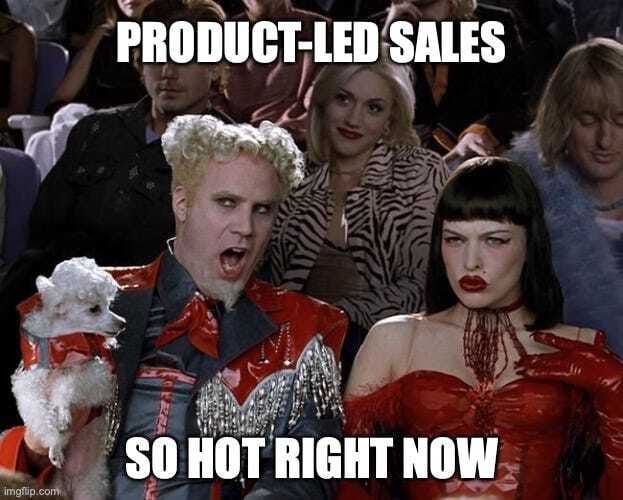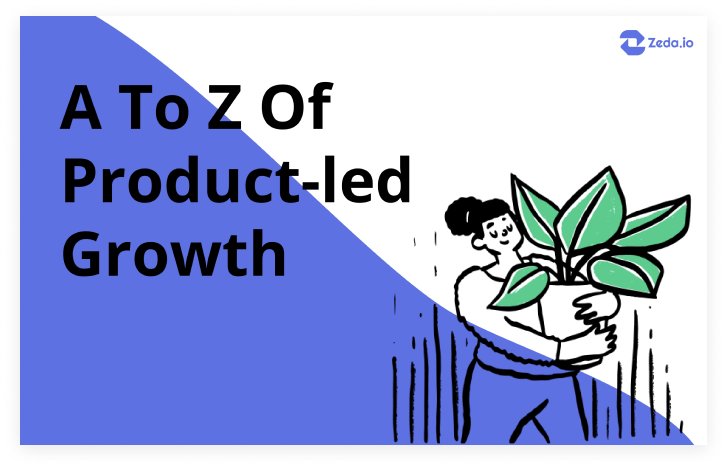Hey - Ben here 👋. Welcome to the latest edition of The Product-Led Geek, the newsletter helping you get smarter about scaling with product-led strategies.
First time reading? Join thousands of founders, leaders and growth operators. Sign up here.
And keep the feedback coming - you can mail me anytime at [email protected]

Here’s what you’ll find in today’s PLGeek:
📅 GEEKS OF THE WEEK: 5 links for you to bookmark
🧠 GEEK OUT: Product-Led Sales - Playbooks 101
😂 GEEK GIGGLE: 1 thing that made me laugh this week.
Total reading time: 5 mins
Let’s go!
Today’s post is brought to you by Zeda.io
Learn how successful product companies leverage product-led growth with this free guide from Zeda.io
✔︎ Learn the basic concepts
✔︎ Know the elements of Product-led growth
✔︎ Product-led strategies
✔︎ Grow organically without ads
✔︎ Real-World Examples
Please support our sponsors!
Enjoying this content? Subscribe to get every post direct to your inbox!
📅 GEEKS OF THE WEEK
5 bookmark-worthy links:
The MKT1 guide to positioning (Emily Kramer)
3 stages of board deck preparation (Carilu Dietrich)
How Calendly overhauled their product-led sales motion (Jessica Gilmartin, CMO/CRO @ Calendly)
Apple Intelligence is right on time (Stratechery)
(BONUS) My failure story (shared on Adam Fishman’s newsletter)
🧠 GEEK OUT
Product-Led Sales - Playbooks 101
Product-Led Sales (PLS) is so hot right now.

And its hotness is entirely justified.
When implemented the right way, you can expect to reduce sales cycle time and lower CAC (relative to traditional outbound sales).
And if you’re coming from the other direction extending a previous self-serve only motion, then you get to go upmarket and reach bigger deals with higher ACVs.
But there’s also a lot of misunderstanding about how to implement an effective PLS initiative.
It can be difficult to know where and how to start.
Let’s first take a step back and get on the same page about where playbooks fit into the big picture.
The product-led sales process
The product-led sales process at a high level is very simple, and can be distilled to 4 key steps:
Collect data about accounts (product usage ++)
Objectively score each account
Act on the subset of accounts that meet scoring criteria
Periodically review performance to improve each of the first 3 steps.

Product-Led Sales @ 50,000 ft
Accounts that meet your scoring criteria are Product Qualified Accounts (PQAs).
The scoring is dynamic and typically includes a recency component, and over time, accounts can go above or below thresholds you define in the scoring criteria.
In other words a PQA today may no longer be a PQA tomorrow, so timely action is imperative.
But what action do you take?
Playbooks, enter stage left.
The anatomy of a PLS playbook
A playbook is a term that’s been used in B2B sales for as long as sellers have been selling.
Playbooks provide a guide for the GTM team that helps bring structure and method to how they work. Their scope can be pretty wide. I’ve seen playbooks including ICP definition, end-to-end sales processes, scripts and templates, competitive positioning, objection handling, metrics, tool enablement and education and more.
When leveraged effectively, they bring consistency to the go-to-market motion that enables more repeatable results and more predictability in revenue.
When establishing a PLS motion, starting small and staying agile is key to create a high learning velocity that allows faster iteration towards a model that reproducibly gets results.
For that reason, I favour early PLS playbooks to be minimal, supporting creativity and experimentation amongst the team.
Playbooks have a goal / objective, and are composed of multiple steps, each taking the account towards the goal.
Some steps will be automated, some will be semi-automated, and other steps will be manual.
Step Type | Example |
|---|---|
Automated | Send a message to a Slack channel to notify the sales team of a new PQA or notify sales management when PQAs have no assigned owner |
Semi-Automated | BDR tailors then sends a templated Salesloft email to one or more PQLs within the account. |
Manual | Calling a PQL within the PQA |
System of Record
Where these playbooks are defined and stored or what medium they’re documented in is less important. Notion, Google Docs, Slides, whatever - use company norms to make sure they’re easy to find, easy to digest, and easy to reference.
It is critical to track the execution of your playbooks though. This can be as simple as a pipeline kanban view in your CRM:

Or you can consider adopting a dedicated PLS tool like Pocus that’s more opinionated but integrates concepts like playbooks out-of-the-box.
Regardless, for every account entered into a play, your reps should know exactly what’s happened to date, and should know the ideal next action they should take to progress the account through the playbook toward the goal.
Automate appropriate parts of your playbooks using the workflow capabilities and integrations of the tool you use.

Geek Tip: Make sure ICP matching is part of your PQA criteria that puts accounts into plays. It’s much easier and faster to iterate your way to predictable playbooks if you focus on potential customers that look and behave similarly.
Where to start with PLS Playbooks
In companies new to PLS, starting with more than one playbook is ill advised.
Always focus on a single playbook to start with.
Identify the top objectives you have for your PLS initiative, and prioritise them.
Typically, you’ll want to focus on the #1 priority objective, but occasionally there will be lower priority objectives that have similar upside while also being less complex to operationalise, and focusing there to build muscle can be preferred.
Get reps in.
Focus on learning, and the feedback loops that will let you iterate to the point where your playbook (and signals/scoring) is leading to repeatable wins.
Then consider expanding to additional plays.
Geek tip: Accounts will become eligible for a play because they have met the criteria you’ve defined.
But not all PQAs are created equal, so you do need to objectively score them so that reps can prioritise their time effectively.
There you have it, a 101 (or foundation, for fear of alienating my fellow Brits) level overview of PLS Playbooks.
In next week’s newsletter, I’ll break down the five most common PLS playbooks.
Unblocking
Conversion
Expansion
Consolidation
Churn Prevention
🙌
😂 GEEK GIGGLE
SHARE THE LOVE → PROFIT

The PLGeek Growth Process
Get the PLGeek Growth Process
Do you know someone that would enjoy this newsletter?
Share it with them and get access to The PLGeek Growth Process. This is a refined version of the growth process I ran that fuelled growth at Snyk and countless companies I’ve advised.
{{rp_personalized_text}}
Or just share this link with them: {{rp_refer_url}}
💪 POWER UP
If you enjoyed this post, consider upgrading to a VIG Membership to get the full Product-Led Geek experience and access to every post in the archive including all guides. 🧠
HELP ME IMPROVE THE PRODUCT-LED GEEK
If there are any product, growth or leadership topics that you’d like me to write about, just hit reply to this email or leave a comment and let me know!

That’s all for today,
Until next time!
Ben

PS: Thanks again to our sponsor: Zeda.io
LOOKING FOR MORE?
Here are 2 ways I can further help you:
1. Book a free 1:1 consultation with me
I keep a few slots open each week for founders and product growth leaders to explore working together and get some free advice along the way. Book a call.
2. Sponsor this newsletter
Learn how to reach over 7300 founders, leaders and operators working in product and growth at some of the world’s best tech companies including Paypal, Adobe, Google, Meta, Tailscale, Twilio and Salesforce. Learn more.

